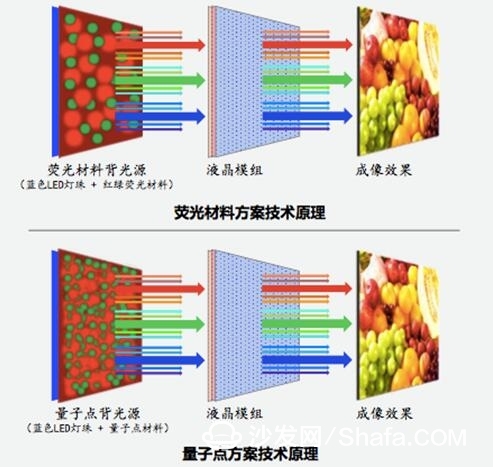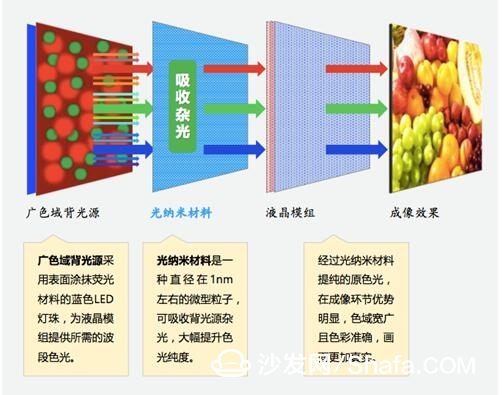After more than ten years of development, LCD TVs have become more and more networked and intelligent. Emerging technologies are emerging and application services are becoming more abundant. However, in the most important aspect of quality, LCD TVs do not seem to have achieved breakthroughs in recent years. The emergence of new technologies, simple color gamut enhancement techniques (such as quantum dots) on the market is nothing more than the blinding of word games, allowing you to see how the color gamut improves from the digital sense, even beyond 100%, while actually watching It is not as beautiful as propaganda, and the situation of color distortion still exists. So, there is no color gamut enhancement technology to solve this problem?
Recently, the top TV manufacturers in the country have introduced a liquid crystal television equipped with a solid color technology, which can maximize the color gamut and maintain a pure picture quality. Let's take a look at how this is done.
In this first give everyone a basic knowledge of the application of electronic display, electronic display devices are based on an important optical principle - additive color mixing method. That is, the color lights of the three primary colors (red, green, and blue) are added in different proportions, and most colors can be mixed. In other words, the colorful screens we see, such as mobile phones, tablets, and TVs, are actually mixed by these three primary colors.
In order to accurately image the electronic display device, the CIE (International Standards and Lighting Committee) specified in 1931 that the CIE-RGB primaries system has been used as a universal standard. The standard stipulates the three primary color standards for the global electronic display devices, ie, the red, green, and blue (B), RGB, and blue (B) wavelengths that specify the three primary colors of the RGB system are 700 nm, 546.1 nm, and 435.8 nm, respectively. ). When the three primary colors of the display device have good light consistency and converge to their respective standard wavelength values ​​indefinitely, the picture formed by the color mixing is closest to the theoretical state, that is, the best performance of the liquid crystal television picture.
In the history of LCD TV picture quality improvement, researchers have made a lot of efforts. In order to improve the color performance of LCD TVs, R&D personnel based on the nature of passive light emission of LCD TVs started with backlights and introduced a wide color gamut backlight and quantum dot backlight, which use red and green fluorescent materials and red and green quantum dot materials respectively. The liquid crystal module provides backlight with a wider color gamut, which greatly enhances the color gamut of the LCD TV. However, these two technologies have failed to increase the color consistency of the primary colors. That is, the three primary colors of red, green, and blue cannot reach the wavelength of 700 nm. , 546.1nm, 435.8nm or concentrated to this, so no matter how high the color gamut, television screen performance is still not up to standard, until the emergence of solid color technology.
So what is solid color technology? What is the principle of pure color technology to improve the quality of pictures?
Pure color technology is a new generation of color enhancement technology that enhances color purity on the basis of achieving a wide color gamut. With the advantages of more accurate colors and more realistic images.
Before we explore the principles of solid color technology, let us understand the two methods of traditional wide color gamut enhancement.
One is a fluorescent material solution. The backlight is a LED lamp that emits blue light, and then smears a red-green fluorescent material to emit red, green and blue primary colors. The other is a quantum dot technology. The backlight is also a blue LED capable of emitting blue light. Lamp beads, blue light emits red and green light after excitation of the quantum dot material. The biggest drawback of these two color gamut enhancement methods is that the red, green, and blue primary colors ultimately emitted are not pure, because they do not purify the red, green, and blue primary colors in the process of enhancing the color gamut, so the three primary colors of red, green, and blue are emitted. The light is not pure. The following figure shows the schematic of the two color gamut promotion methods.

The solid color technology can effectively solve the problem of impure red, green and blue light emitted by the LCD TV backlight. The solution is to add a layer of light nanomaterial between the wide color gamut backlight and the liquid crystal module. The light nano material is After a special special design, it is a miniature particle with a diameter of about 1nm, which absorbs the stray light emitted by the backlight source and enhances the purity of the three primary colors of red, green, and blue. The result is a more accurate representation of the color of the screen and a true picture. This is the principle of solid color technology.

Smart TV/box information can focus on smart TV information network sofa butler (http://), China's influential TV box and smart TV website, providing information, communication, TV boxes, smart TVs, smart TV software, etc. Answering questions.
Recently, the top TV manufacturers in the country have introduced a liquid crystal television equipped with a solid color technology, which can maximize the color gamut and maintain a pure picture quality. Let's take a look at how this is done.
In this first give everyone a basic knowledge of the application of electronic display, electronic display devices are based on an important optical principle - additive color mixing method. That is, the color lights of the three primary colors (red, green, and blue) are added in different proportions, and most colors can be mixed. In other words, the colorful screens we see, such as mobile phones, tablets, and TVs, are actually mixed by these three primary colors.
In order to accurately image the electronic display device, the CIE (International Standards and Lighting Committee) specified in 1931 that the CIE-RGB primaries system has been used as a universal standard. The standard stipulates the three primary color standards for the global electronic display devices, ie, the red, green, and blue (B), RGB, and blue (B) wavelengths that specify the three primary colors of the RGB system are 700 nm, 546.1 nm, and 435.8 nm, respectively. ). When the three primary colors of the display device have good light consistency and converge to their respective standard wavelength values ​​indefinitely, the picture formed by the color mixing is closest to the theoretical state, that is, the best performance of the liquid crystal television picture.
In the history of LCD TV picture quality improvement, researchers have made a lot of efforts. In order to improve the color performance of LCD TVs, R&D personnel based on the nature of passive light emission of LCD TVs started with backlights and introduced a wide color gamut backlight and quantum dot backlight, which use red and green fluorescent materials and red and green quantum dot materials respectively. The liquid crystal module provides backlight with a wider color gamut, which greatly enhances the color gamut of the LCD TV. However, these two technologies have failed to increase the color consistency of the primary colors. That is, the three primary colors of red, green, and blue cannot reach the wavelength of 700 nm. , 546.1nm, 435.8nm or concentrated to this, so no matter how high the color gamut, television screen performance is still not up to standard, until the emergence of solid color technology.
So what is solid color technology? What is the principle of pure color technology to improve the quality of pictures?
Pure color technology is a new generation of color enhancement technology that enhances color purity on the basis of achieving a wide color gamut. With the advantages of more accurate colors and more realistic images.
Before we explore the principles of solid color technology, let us understand the two methods of traditional wide color gamut enhancement.
One is a fluorescent material solution. The backlight is a LED lamp that emits blue light, and then smears a red-green fluorescent material to emit red, green and blue primary colors. The other is a quantum dot technology. The backlight is also a blue LED capable of emitting blue light. Lamp beads, blue light emits red and green light after excitation of the quantum dot material. The biggest drawback of these two color gamut enhancement methods is that the red, green, and blue primary colors ultimately emitted are not pure, because they do not purify the red, green, and blue primary colors in the process of enhancing the color gamut, so the three primary colors of red, green, and blue are emitted. The light is not pure. The following figure shows the schematic of the two color gamut promotion methods.


Vacuum Furnace Insulation Screen
Vacuum Furnace Insulation Screen,Thick Hard Felt Disc,Thick Vacuum Furnace Plate,Thermal Insulation Screen For Vacuum Furnace
HuNan MTR New Material Technology Co.,Ltd , https://www.hnmtr.com